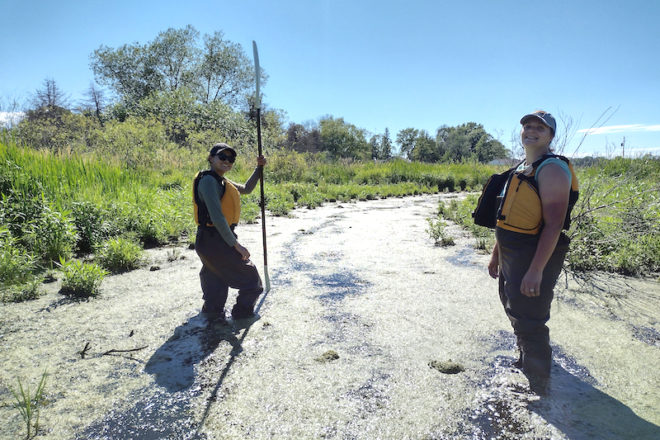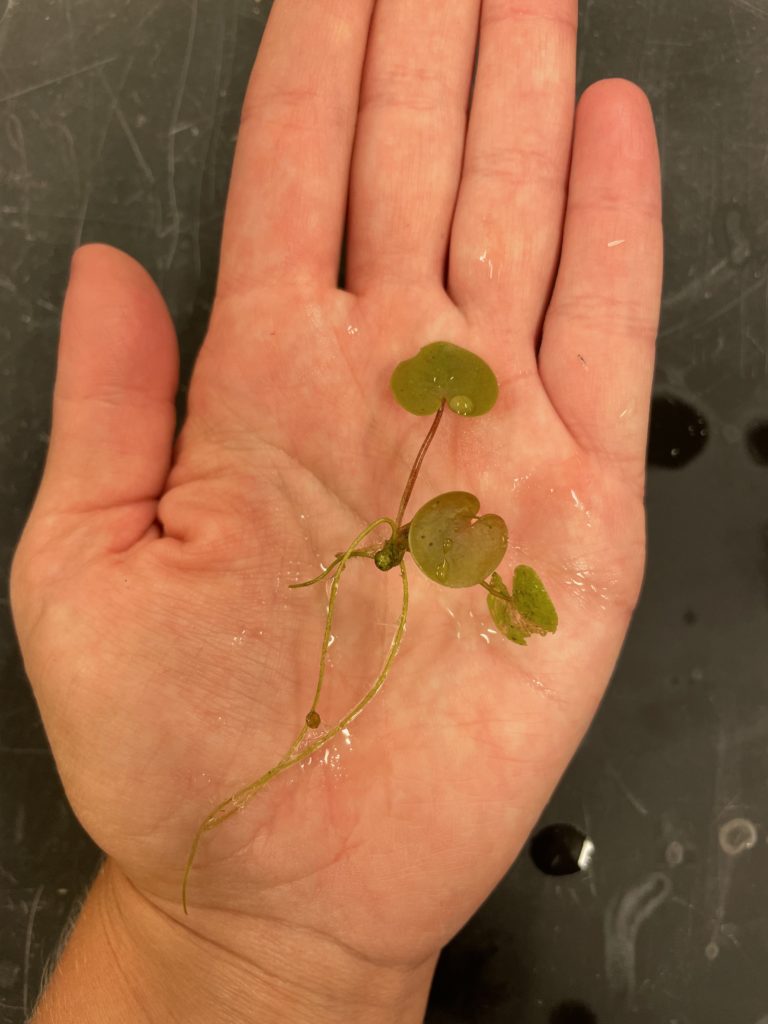Invasive Species Alert: European Frogbit Found in Little Sturgeon and Fish Creek Areas
- Share
- Tweet
- Pin
- Share

Conservationists team up to remove the floating invader
New invasive species keep popping up around the Great Lakes.
When Amanda Smith of the Wisconsin Department of Natural Resources (DNR) discovered the most recent coastal invader recently, Door County groups quickly mobilized to remove as many of the plants as possible.
In keeping with a Great Lakes Restoration Initiative grant for “early detection and rapid-response surveys” in swampy Green Bay shoreline areas, Smith kept searching, and on July 19, she discovered European frogbit near the mouth of Twin Harbor in the Little Sturgeon area. It was the invader’s first confirmed appearance in Door County waters, said Samantha Koyen, Door County Invasive Species Team leader and Door County Soil and Water Conservation Department (SWCD) conservationist.
The floating plant with singular, clover-like, circular, half-dollar-diameter leaves causes concern because it grows densely and can choke out native aquatic plants and impede the movement of aquatic life in backwater areas.
Because of time constraints and the large scope of monitoring efforts for European frogbit, Door County Land Trust, the Wisconsin DNR and the SWCD all quickly teamed up to search for and eliminate European frogbit around the area where it was first discovered.
The second discovery in Door County came Aug. 9 in Peninsula State Park in a narrow arm of a shallow, backwater lagoon within a mile of the Fish Creek entrance to the park.

The DNR, the Door County Invasive Species Team (DCIST) and others are searching for European frogbit themselves because it tends to grow in mucky areas where hikers and boaters don’t often go. However, birders, photographers, kayakers, anglers and other ecologically minded people could encounter it, Koyen said, and they should report any sighting to her, the SWCD or the DNR.
She said it has shown up in areas inhabited by duckweed, cattails and other shallow-water plants.
“It’s such a new species to Wisconsin; it’s only been documented for about a year. There are hopes that maybe there’s a chance for eradication,” Koyen said.
She said the invasive weed spreads through a bud structure on the plant. Conservation employees and volunteers take care not to break off buds, and for now their best method has been scooping up all the frogbit leaves and roots, along with all plants, algae and litter adjacent to it.
“It’s floating. It isn’t secured to the bottom like Eurasian milfoil. It was first found in Wisconsin last year in Marinette and Oconto,” Koyen said, noting that the plant likely drifted across the lake on currents.
Prior to that, it was documented in the Sault Ste. Marie area. Theories differ on how the plant made it to Green Bay shorelines, but some people buy it online for use in aquariums. Wisconsin’s invasive species rule, Code NR 40, prohibits European frogbit statewide.
Koyen said Door County Land Trust stewardship staff members Thomas Stasiak and Tina Lee, as well as SWCD staff members Tim Dahl and Briannna Schroeder were integral in monitoring efforts for frogbit, along with Smith, who is leading that effort throughout the lakeshore basin.
To help, Koyen asks people to report sightings of invasive species to her at [email protected], or to the SWCD or the DNR, and to share a photo if they see a plant or organism they cannot identify.
“If you see something weird or odd, reach out to me or the Door County Invasive Species team,” Koyen said.
Other Invasive-Species Control Efforts
The SWCD has completed its treatments for controlling patches of wild parsnip countywide.
“We controlled 85-plus acres of wild parsnip through our staff and contractors,” Koyen said.
She said DCIST is helping a contractor assemble permits for killing nonnative phragmites in low-lying areas and swampy waterways, and DCIST finished up control efforts of black swallow-wort, a pointy-leaved invasive vine. She said it appears DCIST gained some ground in its battle against the plant in some locations, but in others, there’s still work to be done.


